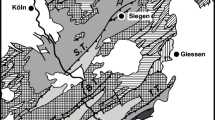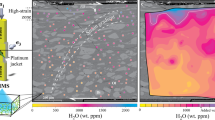Abstract
The Upper Calc-Silicate Unit of the Reynolds Range, central Australia, contains marbles with centimetre-wide layers of metamorphosed marls. Wollastonite-bearing marbles record fluid infiltration by water-rich fluids (XCO2=0.1–0.3) at 650–700 °C and 300–400 MPa during cooling from granulite-facies metamorphism at ∼1.6 Ga. The pattern of fluid flow recorded by stable isotope ratios of calcite, the distribution of wollastonite, and calcite luminescence is heterogeneous on a millimetre-scale. Calcite from decimetre-size hand specimens has δ18O values and δ13C values that vary by up to 10 and 12‰, respectively. The lowest δ18O and δ13C values are centred on millimetre-wide grandite-rich skarn zones, whereas higher values characterise relict calcite that co-exists with quartz. The variation in δ18O values together with related δ13C variations and the abundance of wollastonite may be used to determine the distribution of zones of higher and lower permeability. Skarn zones and regions of low δ18O values at marl–marble contacts mark channels of fluid flow. Fluid flow at the contacts was promoted by the rheological contrast and by the juxtaposition of calcite (in the marble) and quartz (in the marl) that could form abundant wollastonite via the reaction: calcite + quartz=wollastonite + CO2. This reaction results in a large negative volume change, and fluid flow may have been concentrated in a small number of channels once they were established, provided that fluid pressures were sufficient to overcome compaction. Some isolated skarn zones and low δ18O regions within the marbles may be located at the intersections of fractures that would have also been zones of high permeability. The formation of large volumes (>15–20%) of wollastonite within the marble layers requires that silica metasomatism via the reaction calcite + SiO2(aq)=wollastonite + CO2 has occurred, and the grandite skarns record metasomatic addition of Fe. These metasomatic reactions have positive volume changes that would have sealed existing fluid flow channels, allowing new channels to develop elsewhere in the rock. Preservation of steep stable isotope gradients suggests that fluid flow occurred over only a few thousand years after which the rocks were fluid absent.
Similar content being viewed by others
Author information
Authors and Affiliations
Additional information
Received: 12 June 1999 / Accepted: 20 June 2000
Rights and permissions
About this article
Cite this article
Cartwright, I., Buick, I. Millimetre-scale variation in metamorphic permeability of marbles during transient fluid flow: an example from the Reynolds Range, central Australia. Contrib Mineral Petrol 140, 163–179 (2000). https://doi.org/10.1007/s004100000180
Issue Date:
DOI: https://doi.org/10.1007/s004100000180




